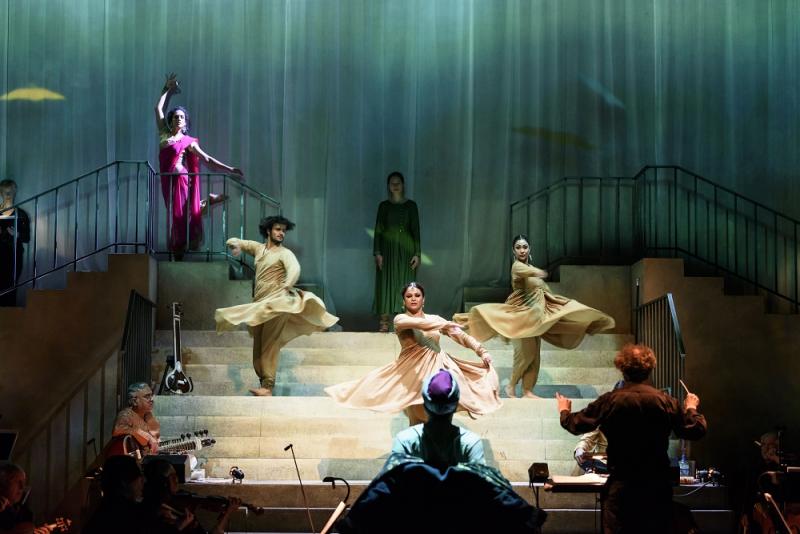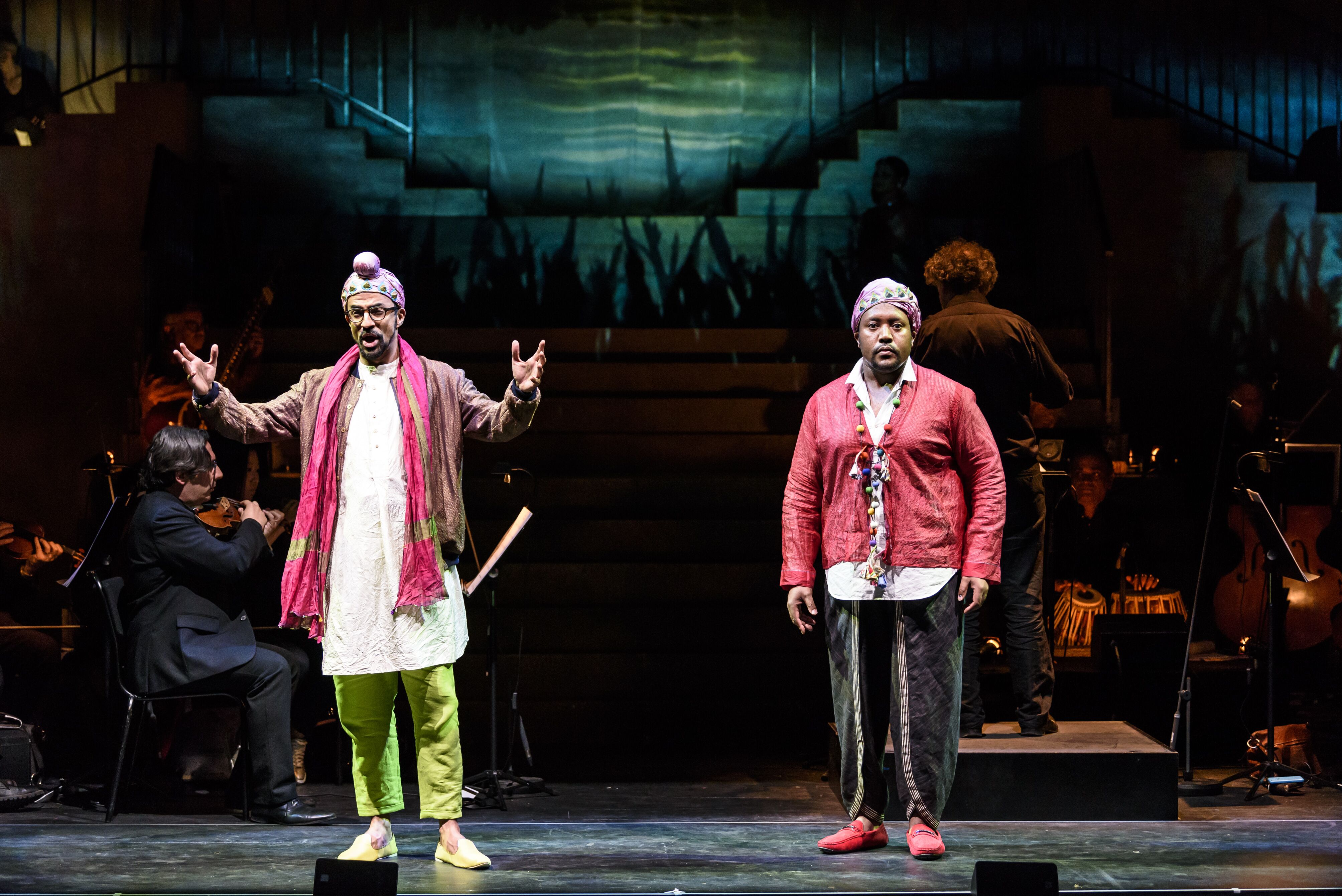Sukanya, RFH review - Ravi Shankar's bright-eyed, varied fable | reviews, news & interviews
Sukanya, RFH review - Ravi Shankar's bright-eyed, varied fable
Sukanya, RFH review - Ravi Shankar's bright-eyed, varied fable
Fine performances, but crude miking suggests this would work better as a chamber opera

Admirable as it was of the London Philharmonic Orchestra to launch its concerts in 2020 with a performance celebrating the Ravi Shankar centenary, the hard fact remains that this lively spectacle might have worked better without two-thirds of its players.
Still, Sukanya should be here to stay, and would reach larger audiences around the country with a chamber ensemble to complement the five Indian instrumentalists, the dancers and the soloists (I'd scrap the chorus, which could rarely be heard here). The essence of this tale adapted from the Mahābhārata epic, taken up by the 90 year old Shankar some time after his mother-in-law pointed out the correspondence between the heroine and his wife of the same name, 30 years younger, tells of a princess who marries an old sage out of compassion, and, when challenged by two demi-gods to pick him out of a threefold identity (for which read identical) parade, sees his soul and wins his rejuvenation.  Though simple, and succinctly told in musical terms which are suprisingly varied given the Indian principal of a drone bass which excludes modulation in any given sequence, the outlines weren't entirely clear in Suba Das's concert staging. Would we have known that Chyavana ages over 100 years in the forest when his representative, vibrant Indian-born, American-trained tenor Alok Kumar, remains a handsome man, his infirmity represented only by his blindness (pictured above). Would you have grasped that the very dissimilar Michel de Souza and Njabulo Madlala (pictured below), comic in Amit Chaudhuri's libretto, were supposed to be beautiful heavenly twins?
Though simple, and succinctly told in musical terms which are suprisingly varied given the Indian principal of a drone bass which excludes modulation in any given sequence, the outlines weren't entirely clear in Suba Das's concert staging. Would we have known that Chyavana ages over 100 years in the forest when his representative, vibrant Indian-born, American-trained tenor Alok Kumar, remains a handsome man, his infirmity represented only by his blindness (pictured above). Would you have grasped that the very dissimilar Michel de Souza and Njabulo Madlala (pictured below), comic in Amit Chaudhuri's libretto, were supposed to be beautiful heavenly twins?
Even so, strong delivery - above all from Susanna Hurrell as an unrelentingly radiant and poised Sukanya - and the music's rich contrasts carried two short acts. Enriched from the start by Parimal Sadaphal's spellbinding sitar and Ashwani Shankar on shehnai, the Indian oboe, each has a spiritual highlight: a universal hymn of thanksgiving led by Jonathan Lemalu's King Shaariyati in the first, Sukanya's joyous reunion with Chyavana towards the end of the second, her solo almost Balkan-sounding in its vibrancy (eastern scales, of course, inflecting some European folk music).  The dance music is exhilarating, too, especially with the punctuation of two exponents in the art of konnakol, a kind of Indian scat singing, in Act Two. It's a pity that Shankar's fusion, completed by expert conductor-violinist David Murphy after his death, doesn't give scope for the microtonal ornamentation and glissandi of genuine Indian ragas, described at length by Chyavana in perhaps the least successful "number" of the opera; the singers remain western-operatic in style, and the setting of the text - predominantly Indian, partly Sanskrit in an infinitely more meaningful way than Glass uses it in the stillborn Satyagraha - means accommodating a lot of words on lines limited by the scales or modes at any given point.
The dance music is exhilarating, too, especially with the punctuation of two exponents in the art of konnakol, a kind of Indian scat singing, in Act Two. It's a pity that Shankar's fusion, completed by expert conductor-violinist David Murphy after his death, doesn't give scope for the microtonal ornamentation and glissandi of genuine Indian ragas, described at length by Chyavana in perhaps the least successful "number" of the opera; the singers remain western-operatic in style, and the setting of the text - predominantly Indian, partly Sanskrit in an infinitely more meaningful way than Glass uses it in the stillborn Satyagraha - means accommodating a lot of words on lines limited by the scales or modes at any given point.
That said, and despite the miking, there was still a strong sense of what Yehudi Menuhin, Shankar's equally great friend and musical collaborator, called "the innocence of rapture" in Indian music, "the ecstatic and spontaneous delight that bind performers and audience alike". I'll be getting hold of the 2017 recording, released this month, and hoping that some enterprising small opera company can get permission to work towards a tourable chamber version.
- Southbank Centre's Shankar 100 continues with a sold-out gala concert and other events through to November
- Read more opera reviews on theartsdesk
rating
Explore topics
Share this article
The future of Arts Journalism
You can stop theartsdesk.com closing!
We urgently need financing to survive. Our fundraising drive has thus far raised £49,000 but we need to reach £100,000 or we will be forced to close. Please contribute here: https://gofund.me/c3f6033d
And if you can forward this information to anyone who might assist, we’d be grateful.

Subscribe to theartsdesk.com
Thank you for continuing to read our work on theartsdesk.com. For unlimited access to every article in its entirety, including our archive of more than 15,000 pieces, we're asking for £5 per month or £40 per year. We feel it's a very good deal, and hope you do too.
To take a subscription now simply click here.
And if you're looking for that extra gift for a friend or family member, why not treat them to a theartsdesk.com gift subscription?
more Opera
 Orpheus and Eurydice, Opera Queensland/SCO, Edinburgh International Festival 2025 review - dazzling, but distracting
Eye-popping acrobatics don’t always assist in Gluck’s quest for operatic truth
Orpheus and Eurydice, Opera Queensland/SCO, Edinburgh International Festival 2025 review - dazzling, but distracting
Eye-popping acrobatics don’t always assist in Gluck’s quest for operatic truth
 MARS, Irish National Opera review - silly space oddity with fun stretches
Cast, orchestra and production give Jennifer Walshe’s bold collage their all
MARS, Irish National Opera review - silly space oddity with fun stretches
Cast, orchestra and production give Jennifer Walshe’s bold collage their all
 Káťa Kabanová, Glyndebourne review - emotional concentration in a salle modulable
Janáček superbly done through or in spite of the symbolism
Káťa Kabanová, Glyndebourne review - emotional concentration in a salle modulable
Janáček superbly done through or in spite of the symbolism
 Buxton International Festival 2025 review - a lavish offering of smaller-scale work
Allison Cook stands out in a fascinating integrated double bill of Bernstein and Poulenc
Buxton International Festival 2025 review - a lavish offering of smaller-scale work
Allison Cook stands out in a fascinating integrated double bill of Bernstein and Poulenc
 Tosca, Clonter Opera review - beauty and integrity in miniature
Happy surprises and a convincing interpretation of Puccini for today
Tosca, Clonter Opera review - beauty and integrity in miniature
Happy surprises and a convincing interpretation of Puccini for today
 Hamlet, Buxton International Festival review - how to re-imagine re-imagined Shakespeare
Music comes first in very 19th century, very Romantic, very French operatic creation
Hamlet, Buxton International Festival review - how to re-imagine re-imagined Shakespeare
Music comes first in very 19th century, very Romantic, very French operatic creation
 Falstaff, Glyndebourne review - knockabout and nostalgia in postwar Windsor
A fat knight to remember, and snappy stagecraft, overcome some tedious waits
Falstaff, Glyndebourne review - knockabout and nostalgia in postwar Windsor
A fat knight to remember, and snappy stagecraft, overcome some tedious waits
 Salome, LSO, Pappano, Barbican review - a partnership in a million
Asmik Grigorian is vocal perfection in league with a great conductor and orchestra
Salome, LSO, Pappano, Barbican review - a partnership in a million
Asmik Grigorian is vocal perfection in league with a great conductor and orchestra
 Semele, Royal Opera review - unholy smoke
Style comes and goes in a justifiably dark treatment of Handelian myth
Semele, Royal Opera review - unholy smoke
Style comes and goes in a justifiably dark treatment of Handelian myth
 Le nozze di Figaro, Glyndebourne review - perceptive humanity in period setting
Mostly glorious cast, sharp ideas, fussy conducting
Le nozze di Figaro, Glyndebourne review - perceptive humanity in period setting
Mostly glorious cast, sharp ideas, fussy conducting
 Fidelio, Garsington Opera review - a battle of sunshine and shadows
Intimacy yields to spectacle as Beethoven's light of freedom triumphs
Fidelio, Garsington Opera review - a battle of sunshine and shadows
Intimacy yields to spectacle as Beethoven's light of freedom triumphs
 Dangerous Matter, RNCM, Manchester review - opera meets science in an 18th century tale
Big doses of history and didaction are injected into 50 minutes of music theatre
Dangerous Matter, RNCM, Manchester review - opera meets science in an 18th century tale
Big doses of history and didaction are injected into 50 minutes of music theatre

Add comment